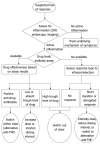Use of the tumor necrosis factor-blockers for Crohn's disease
- PMID: 23002356
- PMCID: PMC3447266
- DOI: 10.3748/wjg.v18.i35.4823
Use of the tumor necrosis factor-blockers for Crohn's disease
Abstract
The use of anti-tumor necrosis factor-α therapy for inflammatory bowel disease represents the most important advance in the care of these patients since the publication of the National Co-operative Crohn's disease study thirty years ago. The recommendations of numerous consensus groups worldwide are now supported by a wealth of clinical trials and several meta-analyses. In general, it is suggested that tumor necrosis factor-α blockers (TNFBs) are indicated (1) for persons with moderately-severe Crohn's disease or ulcerative colitis (UC) who have failed two or more causes of glucocorticosteroids and an acceptably long cause (8 wk to 12 wk) of an immune modulator such as azathioprine or methotrexate; (2) non-responsive perianal disease; and (3) severe UC not responding to a 3-d to 5-d course of steroids. Once TNFBs have been introduced and the patient is responsive, therapy given by the IV and SC rate must be continued. It remains open to definitive evidence if concomitant immune modulators are required with TNFB maintenance therapy, and when or if TNFB may be weaned and discontinued. The supportive evidence from a single study on the role of early versus later introduction of TNFB in the course of a patient's illness needs to be confirmed. The risk/benefit profile of TNFB appears to be acceptable as long as the patient is immunized and tested for tuberculosis and viral hepatitis before the initiation of TNFB, and as long as the long-term adverse effects on the development of lymphoma and other tumors do not prone to be problematic. Because the rates of benefits to TNFB are modest from a population perspective and the cost of therapy is very high, the ultimate application of use of TNFBs will likely be established by cost/benefit studies.
Keywords: Adalimumab; Adverse effects; Certolizumab pegol; Crohn's disease; Economic evaluation; Infliximab; Secondary lack of response; Ulcerative colitis.
Figures
References
-
- Aggarwal BB. Signalling pathways of the TNF superfamily: a double-edged sword. Nat Rev Immunol. 2003;3:745–756. - PubMed
-
- Bernstein CN, Wajda A, Svenson LW, MacKenzie A, Koehoorn M, Jackson M, Fedorak R, Israel D, Blanchard JF. The epidemiology of inflammatory bowel disease in Canada: a population-based study. Am J Gastroenterol. 2006;101:1559–1568. - PubMed
-
- Peyrin-Biroulet L, Deltenre P, de Suray N, Branche J, Sandborn WJ, Colombel JF. Efficacy and safety of tumor necrosis factor antagonists in Crohn’s disease: meta-analysis of placebo-controlled trials. Clin Gastroenterol Hepatol. 2008;6:644–653. - PubMed
-
- Gommerman JL, Browning JL. Lymphotoxin/light, lymphoid microenvironments and autoimmune disease. Nat Rev Immunol. 2003;3:642–655. - PubMed
-
- Schottelius AJ, Moldawer LL, Dinarello CA, Asadullah K, Sterry W, Edwards CK. Biology of tumor necrosis factor-α- implications for psoriasis. Exp Dermatol. 2004;13:193–222. - PubMed
Publication types
MeSH terms
Substances
LinkOut - more resources
Full Text Sources
Medical



